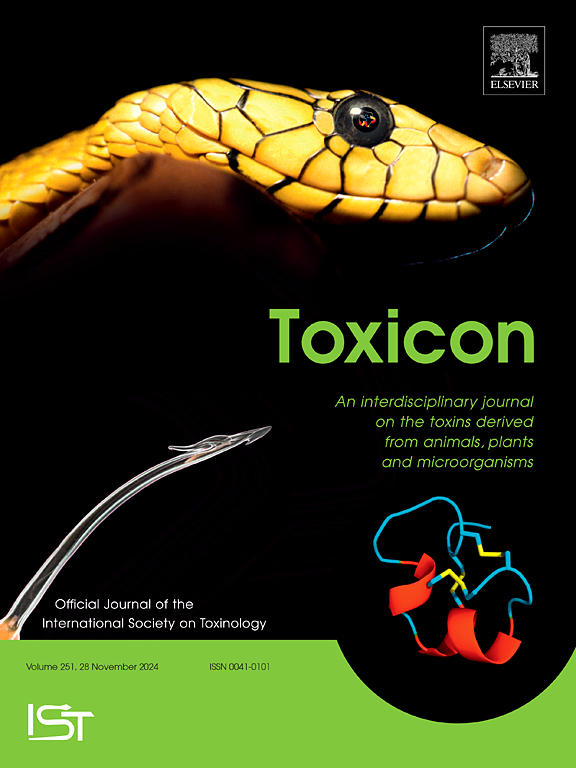Crotoxin modulates Encephalitozoon cuniculi-infected macrophages toward the M1 microbicidal profile
IF 2.6
4区 医学
Q2 PHARMACOLOGY & PHARMACY
引用次数: 0
Abstract
Crotoxin (CTX), a bioactive extract from the snake Crotalus durissus terrificus, has antibacterial, antitumor, and anti-inflammatory properties. Microsporidia are opportunistic, obligate intracellular fungi that infect vertebrates and invertebrates and are highly resistant to conventional drugs. They can also subvert the microbicidal activity of M1 macrophages to an M2 profile, which is more favorable for the pathogen. Thus, in this study, we evaluated the effects of CTX on the viability of spores of the microsporidium Encephalitozoon cuniculi, as well as on the microbicidal activity of macrophages in vitro. E. cuniculi spores were treated with two concentrations of CTX (2.4 and 4.8 μg/mL) and cultivated in RK-13 cells for viability analysis. Additionally, peritoneal adherent cells (APerC), obtained from peritoneal washes of BALB/c mice, were infected with spores of E. cuniculi for 1 h and treated with CTX for 3 h. The profile of macrophages, cytokine production, viability of macrophages, and proliferative capacity of spores were subsequently evaluated. Treatment of E. cuniculi spores with CTX had no fungicidal or fungistatic effects. Compared to the macrophages in the control group, macrophages infected with E. cuniculi and treated with 2.4 μg/mL CTX presented an increase in the M1 profile, more necrosis, and greater production of the cytokines TNF-α and IL-6, and the spores obtained from these macrophages presented a reduction in proliferative capacity. These results indicated that CTX modulated the M1 profile of macrophages infected with E. cuniculi, resulting in greater production of proinflammatory cytokines and stronger microbicidal activity.

响尾蛇毒素调节cucuuliencephalitozoon感染的巨噬细胞向M1杀微生物谱
响尾蛇毒素(Crotalus durissus terrificus)是一种从响尾蛇中提取的生物活性物质,具有抗菌、抗肿瘤和抗炎作用。微孢子虫是一种机会性的专性细胞内真菌,可感染脊椎动物和无脊椎动物,并且对常规药物具有高度耐药性。它们还可以破坏M1巨噬细胞的杀微生物活性,使其变成对病原体更有利的M2型。因此,在本研究中,我们在体外评估了CTX对网状脑小孢子虫孢子活力的影响,以及对巨噬细胞杀微生物活性的影响。用两种浓度的CTX(2.4和4.8 μg/mL)处理棘球蚴孢子,培养于RK-13细胞中进行活力分析。此外,从BALB/c小鼠的腹膜洗涤中获得的腹膜贴壁细胞(APerC),用弓形芽孢杆菌孢子感染1小时,并用CTX处理3小时。随后评估巨噬细胞的特征、细胞因子的产生、巨噬细胞的活力和孢子的增殖能力。CTX对棘球绦虫孢子无杀真菌和抑真菌作用。与对照组的巨噬细胞相比,经2.4 μg/mL CTX处理的巨噬细胞M1谱增加,坏死增多,细胞因子TNF-α和IL-6的产生增多,从这些巨噬细胞中获得的孢子增殖能力降低。这些结果表明,CTX调节巨噬细胞感染的M1谱,导致更多的促炎细胞因子的产生和更强的杀微生物活性。
本文章由计算机程序翻译,如有差异,请以英文原文为准。
求助全文
约1分钟内获得全文
求助全文
来源期刊

Toxicon
医学-毒理学
CiteScore
4.80
自引率
10.70%
发文量
358
审稿时长
68 days
期刊介绍:
Toxicon has an open access mirror Toxicon: X, sharing the same aims and scope, editorial team, submission system and rigorous peer review. An introductory offer Toxicon: X - full waiver of the Open Access fee.
Toxicon''s "aims and scope" are to publish:
-articles containing the results of original research on problems related to toxins derived from animals, plants and microorganisms
-papers on novel findings related to the chemical, pharmacological, toxicological, and immunological properties of natural toxins
-molecular biological studies of toxins and other genes from poisonous and venomous organisms that advance understanding of the role or function of toxins
-clinical observations on poisoning and envenoming where a new therapeutic principle has been proposed or a decidedly superior clinical result has been obtained.
-material on the use of toxins as tools in studying biological processes and material on subjects related to venom and antivenom problems.
-articles on the translational application of toxins, for example as drugs and insecticides
-epidemiological studies on envenoming or poisoning, so long as they highlight a previously unrecognised medical problem or provide insight into the prevention or medical treatment of envenoming or poisoning. Retrospective surveys of hospital records, especially those lacking species identification, will not be considered for publication. Properly designed prospective community-based surveys are strongly encouraged.
-articles describing well-known activities of venoms, such as antibacterial, anticancer, and analgesic activities of arachnid venoms, without any attempt to define the mechanism of action or purify the active component, will not be considered for publication in Toxicon.
-review articles on problems related to toxinology.
To encourage the exchange of ideas, sections of the journal may be devoted to Short Communications, Letters to the Editor and activities of the affiliated societies.
 求助内容:
求助内容: 应助结果提醒方式:
应助结果提醒方式:


